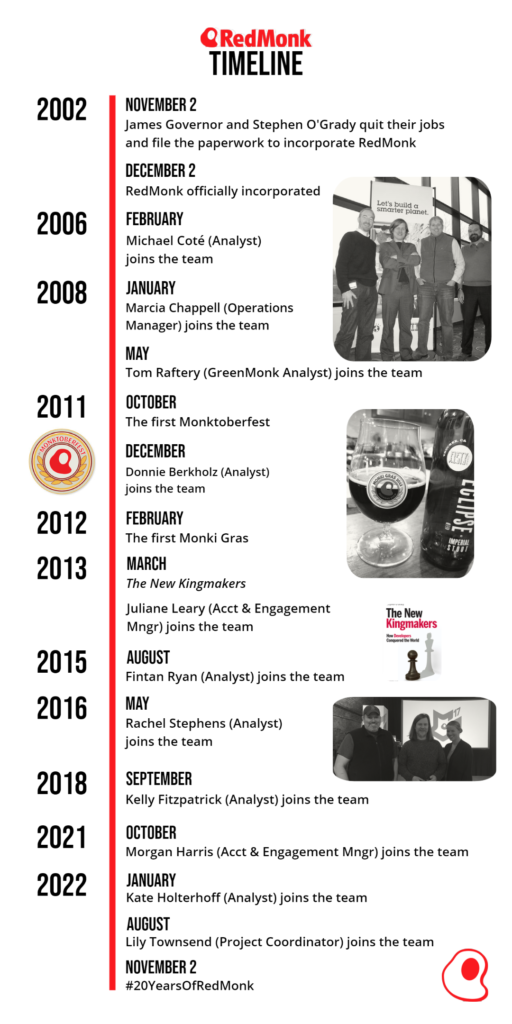
My colleague Steve majored in history. Thus far he and James (who has a background in philosophy and journalism, among other things) have done an excellent job of cataloging some of RedMonk’s milestones:
- Our 5th birthday
- Our 10th birthday
- Our 14th birthday (this time in podcast form)
- Our 15th birthday
However, sometime between 2017 and when RedMonk turned 20 earlier this month, James and Steve became less than eager to talk about RedMonk in chronological terms. As Steve writes in his Birthday Surprise post (a reaction to the #20YearsOfRedMonk hashtag that mysteriously emerged on Twitter):
You have to understand that for years we have had one rule at RedMonk. One simple rule. The first rule of RedMonk is that you never, under any circumstances, talk about how old RedMonk is. If RedMonk got old, after all, how old would that make us?
For years then we’ve deflected questions during introductions with vague replies like, “well, we’ve been doing this longer than we care to admit” or similar platitudes.
With our founders doing everything they can to avoid uttering the phrase “20 years” the rest of the current Monks have taken it upon ourselves to put together a very unofficial (and by no means complete) history of RedMonk so far. And because I am a medievalist trained to deal with very old formats and narratives, we decided to put this on my blog. But make no mistake: this was a team effort (except for any typos or errors, which are mine alone), and we even got Steve and James to talk about what it was like founding an analyst firm two decades ago.
In true (neo)medieval(ish) bricolage fashion, what follows is part chronicle and part list of links, with some interview excerpts and photos thrown in. Many thanks to all the Monks for their contributions to this effort, and to our alums, friends, and larger community for helping us to celebrate RedMonk’s 20th birthday.
2002
Steve takes a job at Illuminata, where he joins James’s team. For various reasons (mostly macroeconomic), James and Steve decide to strike out on their own. On the origin of the company and its name (as told during an all-hands call on Nov. 2, 2022):
James: We’re at an IBM event with a guy called Steve Mills, who did a fair bit to help create the modern software business, certainly turning IBM into a business that had a software business. And he was talking about their rivals, their arch rivals. IBM always saw themselves rivaling Microsoft. And so you had Microsoft’s headquarters in Redmond (WA) and then IBM was founded in Armonk (NY). So I took Redmond and Armonk and I just went: call it RedMonk. And we’ve got a company name now, so we should totally do a company.
Steve: We’ve got to provide the proper color for that comment. In other words, James had done all the hard work and heavy lifting of coming up with the name and the justification, everything else. And he came to me and said, “Hey, I think I have this name: RedMonk. We should discuss it.”
And I said, “Great.”
He went, “Wait, what? You don’t even want to talk about it?”
I said, “Dude, I just came out of a bunch of dotcom era startups with weird spellings. In every client meeting I was in it was like, ‘What are you?’ No, not doing that anymore.”
James wanted a discussion about the name. And I didn’t care. I’m a practical person. We can spell it. Great.”
November 2
James and Steve quit their jobs and file the paperwork to incorporate RedMonk.
December 2
RedMonk is officially incorporated.
While we could not track down a year for the current design of the RedMonk logo, a bit on its origins:
today I learned that the @redmonk logo is designed based on Sean Connery in The Name of the Rose, and I am so delighted pic.twitter.com/PdrrrKZ6Na
— Rachel Stephens (@rstephensme) January 31, 2019
2003
April
The earliest RedMonk blog posts and website materials that we could track down date to 2003. A few snapshots (courtesy of Rachel Stephens and the Way Back Machine):
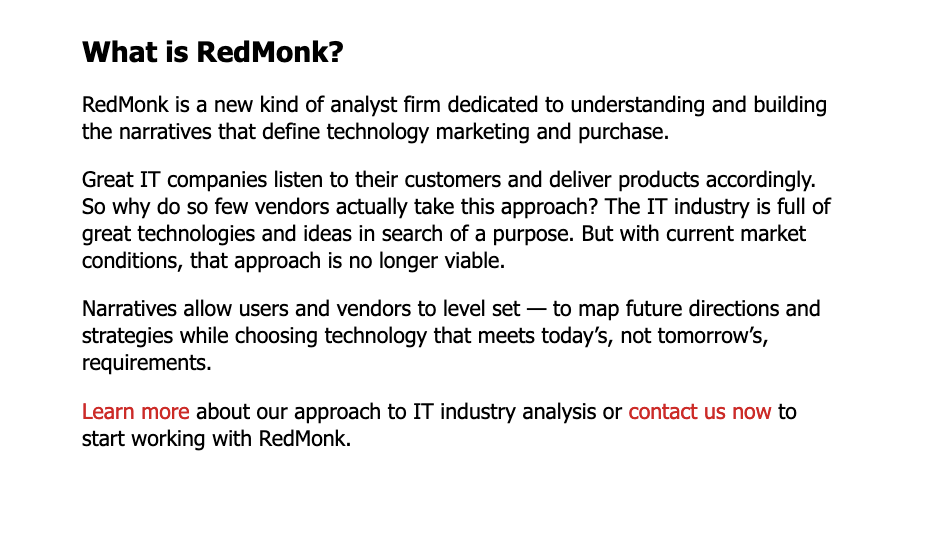
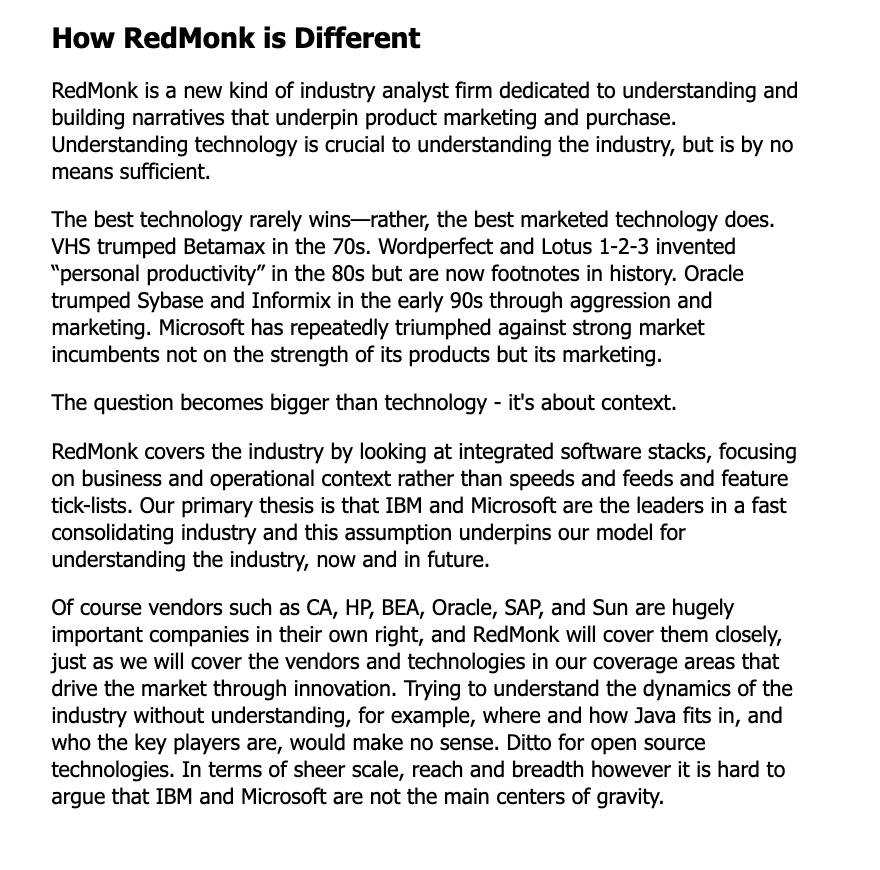
May
The earliest post we can find from Steve (and it is about dinosaurs): Pandora’s Box, Jurassic Park, and DRM
June
The earliest post we can find from James: Peoplesoft & JD Edwards: An IBM Narrative
2006
February
Michael Coté (Analyst, 2006-2011) joins the team
- Coté’s Hello World post
- James: And then We Were Three
- Steve: Say Hi to the New Guy
- Coté’s Last Day post
July
James drops a post about Dave Lidell (then at IBM and important to the RedMonk origin story): On Building a World Class AR Team, David Liddell, and Lessons in Business Ethics and the Entrepreneur Mindset
2007
RedMonk at JavaOne (photo courtesy of Michael Coté via a since-deleted tweet):
2008
January
Marcia Chappell (Operations Manager, 2008-present) joins the team, originating the Operations Manager role
One of the best parts of the RedMonk origin story that we heard during our all-hands call on Nov. 2, 2022 was about how integral Marcia has been to RedMonk’s survival:
Steve: [Marcia] came on board and I literally walked over with a box of receipts that I think there were invoices. And I said, “Can You help with this?”
Marcia: Expense receipts. Everybody just kept all the paper receipts.
Steve: Yeah, I used to mail checks. I had to physically mail checks to James and Coté. We had no idea what we were doing. We started the business. And then you’re trying to keep the business running. And particularly the early days, you’re trying to run lean and not acquire a lot of help. And a lot of things we take for granted now–software as a service at the most basic level, but also part time assistance for a lot of back office type tasks, you know, things like TaskRabbit–none of that stuff existed. You had to either hire for it or figure it out yourself.
[…]
James: I can’t even imagine. I’m so glad because this is the thing. I mean, if Steve is bad at these things, then I’m bad at them to a much, much deeper level than than Steve is.
Steve: I remember talking to somebody–maybe it was Marcia?– and they asked, “Are you doing this stuff because you’re better at it?” And I said, “No, I’m slightly less bad at it.” That’s about it. That’s why we have hired Marcia and other people over the years to try to take care of the things that I’m just slightly less bad at.
James: Regarding hiring Marcia: I can’t think of a better decision in any field or walk of my life than hiring Marcia. So it was fantastic. Because of all of the things that me and Steve are absolutely terrible at.
May
Tom Raftery (GreenMonk Analyst, 2008-2016) joins the team and GreenMonk is born
- James: Announcing New Line of Business, New Analyst: Greenmonk’s Tom Raftery
- All Tom’s posts: https://greenmonk.net/
c. 2009/2010
We could not find a precise date for this photo (courtesy of Michael Coté via a since-deleted tweet) so this is an approximation: Tom, James, Steve, and Coté at an IBM event
2010
Kate Lynch O’Grady begins dispensing always sage advice as RedMonk’s General Counsel (c. 2010-present); she will also be integral to the creation of The Monktoberfest
2011
October

The Monktoberfest is born (from a tweet)
wonder how many folks i could get to come to Maine for a tech/beer conference. Top 2 venues in the world are here: http://bit.ly/iaEToI
— steve o'grady (@sogrady) February 17, 2011
- Steve: A brief history of the Monktoberfest
- Steve and Kate O’Grady in a podcast episode on So you want to throw a conference?
December
Donnie Berkholz (Analyst, 2011-2015) joins the team
- Steve: Meet the New Monk: Donnie Berkholz
- James: New Era At RedMonk: Heeeeeeeeeeeeeeeeeere’s Donnie!
- Donnie: The littlest Monk
- Donnie: The end of this story
2012
February
The first Monki Gras
- James: Our first major European conference is taking shape nicely
- James: On The Genesis, Present and Future of Monki Gras – technical and social bridgebuilding
(Photo courtesy of Laurel Ruma)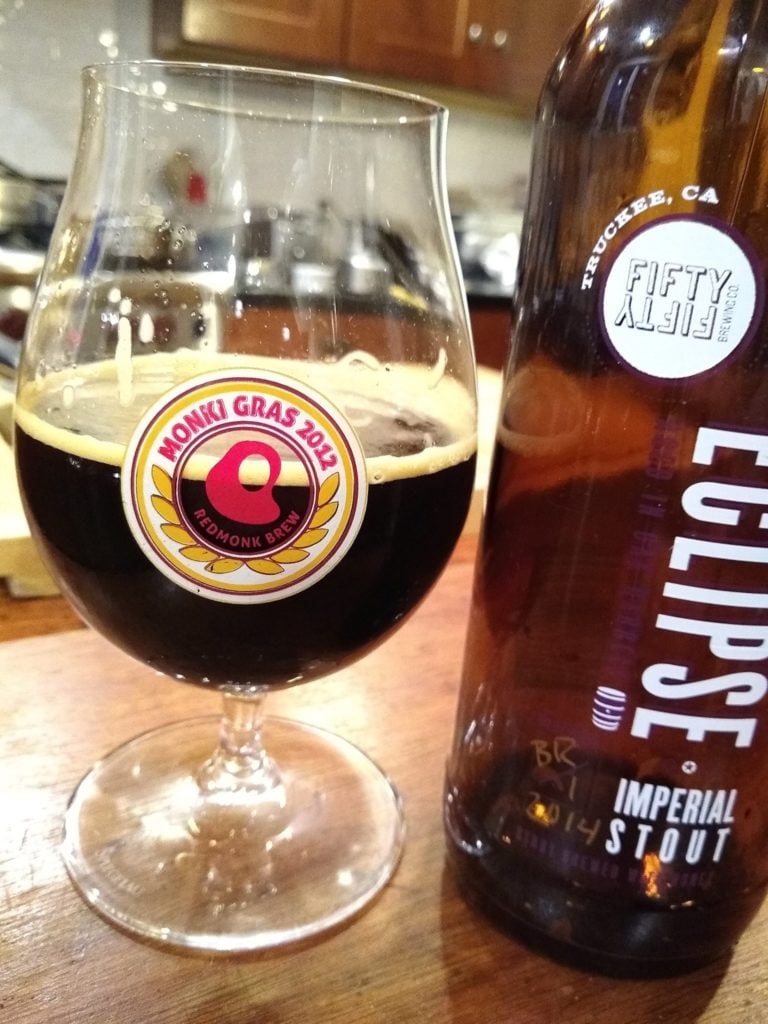
September
The RedMonk Programming Language Rankings takes its current form; earlier iterations:
- The RedMonk Programming Language Rankings: February 2012
- Revisiting the Dataists Programming Language Rankings
2013
March
Steve publishes The New Kingmakers: How Developers Conquered the World

Juliane Leary (Account & Engagement Manager, 2013-2021) joins the team, originating the Account & Engagement Manager role
December
The first ThingMonk
- James: ThingMonk: It lives
Photo from the first ThingMonk (courtesy of Crispin Veall):
2015
May
Steve publishes The Software Paradox: The Rise and Fall of the Commercial Software Market
October
Rachel Stephens helps coordinate The 2015 Monktoberfest (jump to May 2016 to see what happened next)
Kelly Fitzpatrick attends her first Monktoberfest, meets Rachel and the Monks, and decides that she would consider working at RedMonk just to be able to go to Monktoberfest every year (jump to September 2018 for the rest of this story)
August
Fintan Ryan (Analyst, 2015-2018) joins the team
- Steve: Meet the New Monk: Fintan Ryan
- Fintan: Hello World!
- Fintan: 42 Sentiments
2016
May
Rachel Stephens (Analyst, 2016-present) joins the team
- Steve: Meet the New Monk: Rachel Stephens
- Rachel: Hello world!
2017
Steve, James, and Rachel at Monki Gras 2017 in London (photo courtesy of Claire Giordano):
2018
August
James solidifies his thoughts around Progressive Delivery, a term he helped coin.
- James: Towards Progressive Delivery
September
Kelly Fitzpatrick (Analyst, 2018-present) joins the team
- Steve: Meet the New Monk: KellyAnn Fitzpatrick
- Kelly: Salve Munde!
2021
October
Morgan K. Harris (Account and Engagement Manager, 2021-present) joins the team
2022
January
Kate Holterhoff (Analyst, 2022-present) joins the team
- Steve: Meet the New Monk: Kate Holterhoff
- Kate: Hello World!
August
Lily Townsend (Project Coordinator, 2022 – present) joins the team and originates the Project Coordinator role
October
The 2022 Monktoberfest, where Steve, Lily, Rachel, Morgan, Kelly, and James got to meet up in person (photo courtesy of Rachel Stephens):
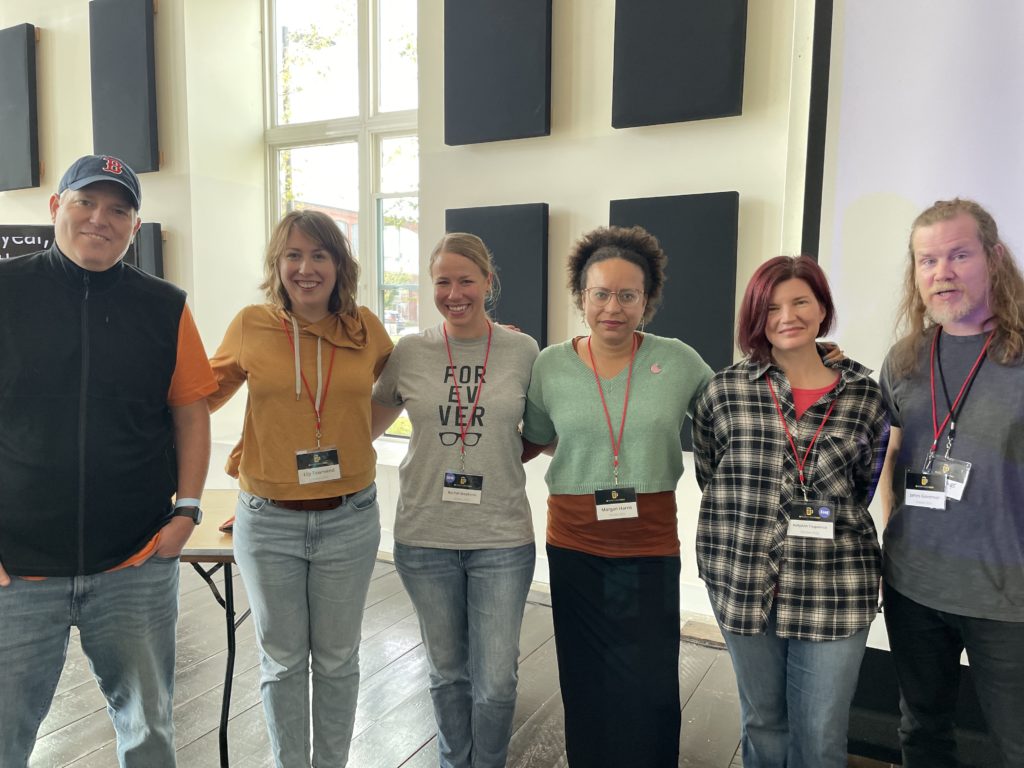
November 2
Twitter celebration (while Twitter is still a thing) of #20YearsOfRedMonk
A few tweets from our amazing community (thank you!)
Happy 20th birthday to Redmonk!
Today, the tech industry takes for granted that developers and OSS communities decide what SW we use
Gone are the days of Sun, HP and IBM boxware sold to COOs
No team has done more to establish this truth than @monkchips and @sogrady
Cheers! pic.twitter.com/upUXIPhZT2
— Alexis Richardson (@monadic) November 2, 2022
I'm jumping in on the #20yearsofredmonk love to share a bit about how @monkchips has directly impacted my life and positively influenced the trajectory of my career. 🧵
— Katie Reese (@katiereese317) November 2, 2022
Covering developers from REDmond to ArMONK = REDMONK #20YearsOfRedMonk 💜
— Jeffrey Borek 🇺🇦 (@jeffborek) November 3, 2022
Happy #20YearsOfRedMonk! Always the best chats about everything in life…not just the tech. Humbled to be sharing some time on this big ol spinning orb with y'all wonderful humans 😊 https://t.co/Hw188B5Zbj
— Betty Junod (@BettyJunod) November 4, 2022
https://twitter.com/IamStan/status/1587742731132092417
They have created a highly respected company and cultivated a vibrant community.
Steve and James are exceptional, and truly embrace their company values. Their work has impacted the lives of many & continues to do so. (10/10)
Cheers to another 20 years. 🍻
— Jessica West (@jessicaewest) November 2, 2022
https://twitter.com/piewords/status/1587763394324602880
#20YearsOfRedMonk TL;DR: Good conversation with good people, over good food and drinks.
Smoking Goat, double espressos and walks, early afternoon drinks over my and others' careers (THANK YOU), a whole table of cider selections, conferences, invaluable advice. ☺️ pic.twitter.com/zLoK2hVJQ0— Maya Kaczorowski (@MayaKaczorowski) November 2, 2022
https://twitter.com/skpodila/status/1587938879323090944
https://twitter.com/the_spinmd/status/1587772352103866368
Happy 20th Birthday @redmonk! Congratulations on the truly incredible community you've built around open source and tech… reading the tweets to #20YearsofRedMonk is just amazing! ❤️ I am so grateful to have met and learned from many of you at Monktoberfest!
— Steph Yiu (@crushgear) November 2, 2022
Developer! Developers! Developers!@monkchips @sogrady…On behalf of the #Java Team at @Oracle, we'd like to wish @redmonk a Happy 20th Anniversary!
Thank you for continuing to focus on the important role developers have with influencing IT decisions.#20YearsOfRedMonk pic.twitter.com/ROc4fyDdFw
— Sharat Chander | 🟧🟦 (@Sharat_Chander) November 2, 2022
I'm pretty sure my introduction to Redmonk was when, without tagging, the entire team found me critically praising and analyzing their quarterly programming report on Twitter.
Open source + data nerds, unite!
Wishing @sogrady + @monkchips all the best <3 #20YearsOfRedMonk
— Madame Treasurer commandasaurus 🦖 (@amcasari) November 2, 2022
Somehow back in 2012 I saw this small ad in the back of a bar in Shoreditch or something https://t.co/bmwi3sz0lZ and thought well that sounds like an interesting event why don't I turn up and see what it is… #20yearsofredmonk
— Justin Cormack (@justincormack) November 2, 2022
#20YearsOfRedMonk pic.twitter.com/kw46sw4flm
— rita (@ritam) November 2, 2022
https://twitter.com/whitecoatcapxg/status/1588137458658689024
Congratulations to @sogrady and @monkchips for #20YearsOfRedMonk! Your insights into developers over the years has been wonderful. And #Monktoberfest is always excellent!
Here's some photos from @TrishPhoto when we attended in 2012. pic.twitter.com/DD4sGYvmtK
— Matt Raible (@mraible) November 2, 2022
Mega congrats to two visionaries and their team! @monkchips and @sogrady no words can express my gratitude for what you've done for the world of technology AND the world in general. (thread)#20YearsOfRedMonk pic.twitter.com/mDoY6eDsz4
— Charlie Isaacs (@charlieisaacs) November 2, 2022
Today we celebrate 20 years of @redmonk!
Huge thank you to @monkchips @sogrady, and team for your support and kindness – you truly make us all better humans. #20YearsOfRedMonk pic.twitter.com/hdipiJQ1sX
— Farrah C (@FarrahC32) November 2, 2022
And from some current and former Monks (also thank you!)
Today is @redmonk’s 20th anniversary! Share your anecdotes, stories, pictures, video clips, your favorite moments with Steve and James, ways RedMonk has impacted you, your personal highlights from Monktoberfest/Monkigras/ThingMonk, or just general RedMonk love. #20YearsOfRedMonk
— Lily Townsend (@lilytownsend23) November 2, 2022
https://twitter.com/cote/status/1587826015182753792
.@redmonk made an extraordinary impact on my life and my career path.
As a fan, part of the community, a RedMonk myself, now #RedMonkAlumni, and a happy customer more than once.
Cheers to you, @sogrady and @monkchips, for making it all possible! #20YearsOfRedMonk https://t.co/bDuIo5qzFT
— Donnie Berkholz, Ph.D. (@dberkholz) November 2, 2022
Cheers to 20 years @monkchips and @sogrady! 🍻 Congrats on building a successful firm and best wishes for the future. #20YearsOfRedMonk
— Juliane Leary (@JulianeLeary) November 3, 2022
Always focused on practitioners, @sogrady & @monkchips, with current @redmonk analysts @drkellyannfitz, @rstephensme & @KateHolterhoff have a huge impact on tech.
So lucky to be #RedMonkAlumni with @cote, @dberkholz & @TomRaftery. Thank you James & Steve. #20YearsOfRedMonk
— Fintan Ryan (@fintanr) November 2, 2022
Today @redmonk turns 20, and I've been lucky enough to be here for the past 6 of them.
I've learned that praise makes @monkchips and @sogrady deeply uncomfortable. We have one day every two decades to say nice things, so I have to make this count. 🙂
— Rachel Stephens (@rstephensme) November 2, 2022
https://twitter.com/jackheatseek/status/1587790671263707136
It's been an eventful #20YearsOfRedMonk celebration for all of us here on the @redmonk team. So many heartfelt & well-deserved accolades for co-founders @sogrady & @monkchips.
Thanks for all you do, & here's to the next 20 years 🍻 🍾 pic.twitter.com/HaA5YwqHNR
— Dr. Kate Holterhoff (@KateHolterhoff) November 3, 2022
Photo credits: are listed in the written timeline above. The timeline graphic at the start of this post is the brainchild of Dr. Kate Holterhoff.
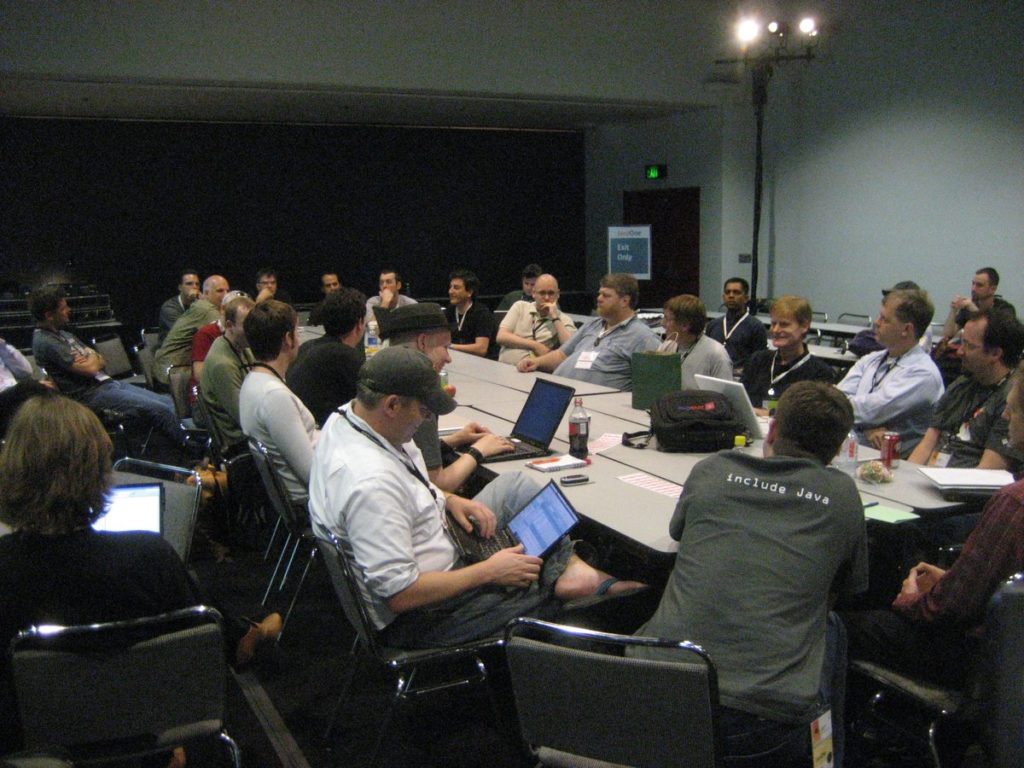
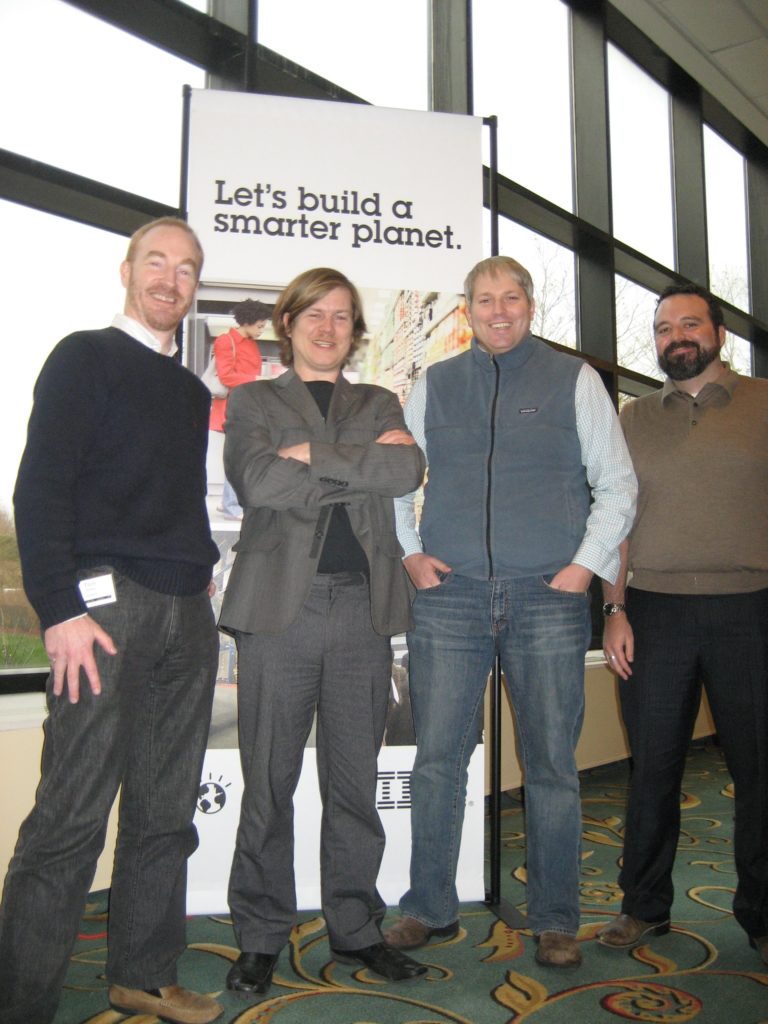
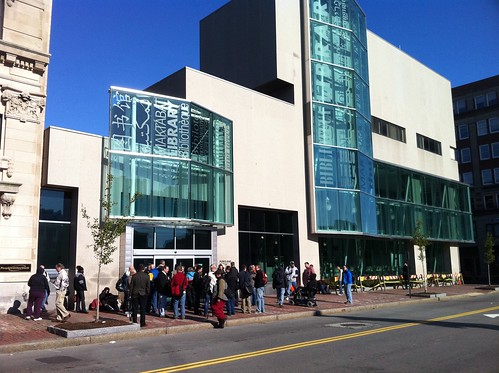
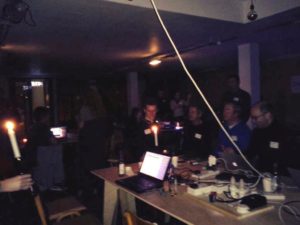

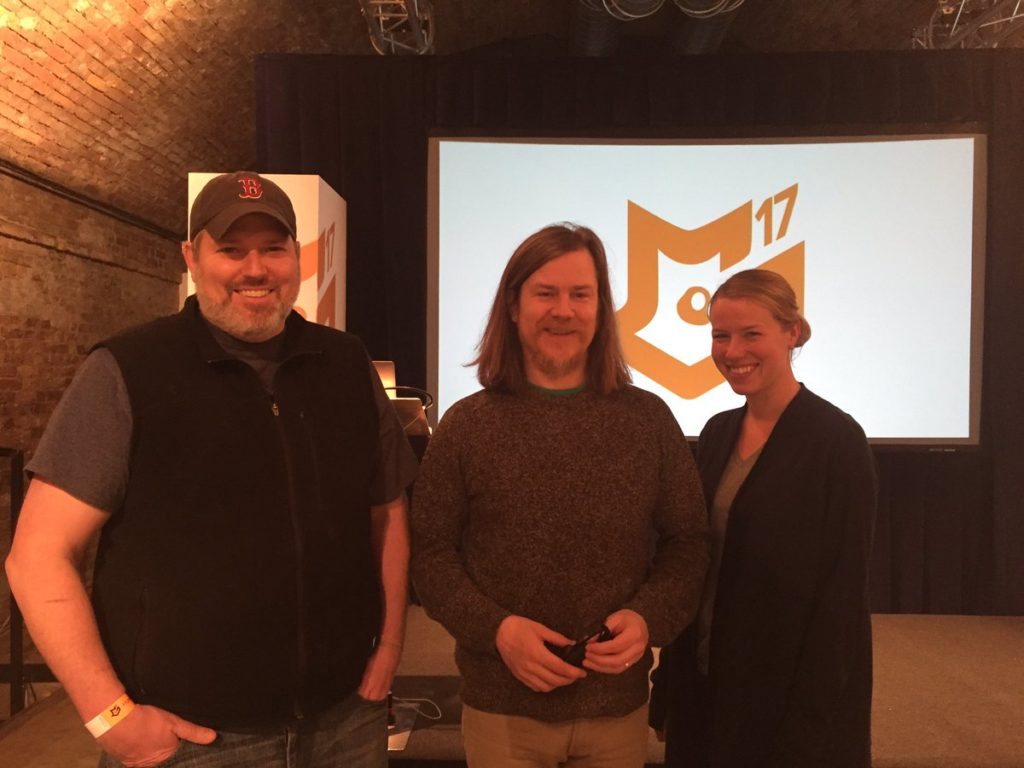
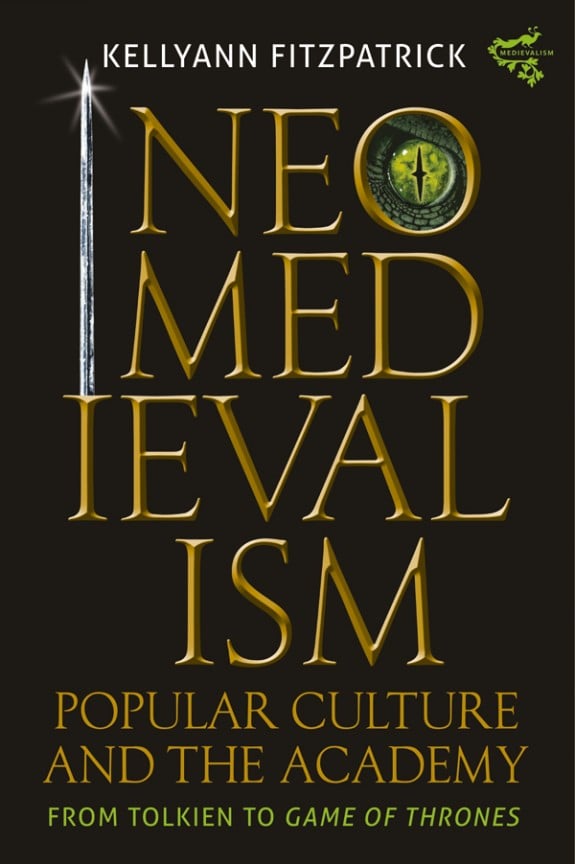
No Comments